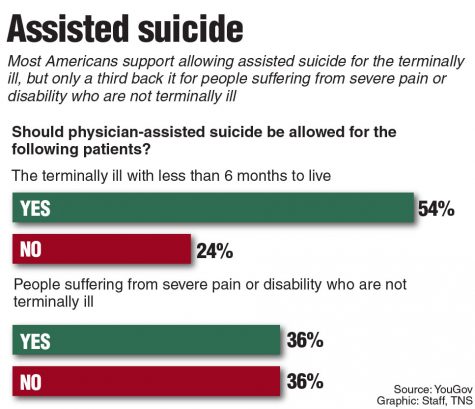Dignified Death
Assisted suicide preserves the autonomy of terminally ill patients.
Since the writing of the Constitution, American citizens have been awarded three unalienable rights, among others: life, liberty, and the pursuit of happiness—but 10 states, from Hawaii to Maine, rightly added “assisted suicide” to that list of rights. Called the “Death with Dignity Laws,” they permit terminally ill patients with the mental capacity to make medical decisions to be prescribed lethal medication.
Maine became the 10th jurisdiction to legalize assisted suicide in June, with it officially going into effect last week and more states are expected to follow, according to CNN. Now, with the recent innocent verdict on a high profile assisted suicide case in the Netherlands, the debate of whether assisted suicide should be permitted at all in the United States resurfaced.
Many believe assisted suicide is a “slippery slope,”. In Australia, however, where assisted suicide is legal, the laws regarding it have changed very little and the qualifications to receive assisted suicide have stayed rigid, according to ABC. More morally-centered views argue that assisted suicide promotes suicide as a whole and portrays it as an escape from all pain. However, this method of thinking ignores the blatant differences between need-based, scientifically and psychologically determined medically administered suicides and regular suicides. A terminally ill patient’s physical and mental pain cannot be ignored, and they should not be forced to keep living in the unbearable conditions of that illness, especially when the end of their life is certain.
Seventy-two percent of Americans support euthanasia, or assisted suicide, according to a May 2018 Gallup poll, and with good reason. Assisted suicide offers autonomy to the terminally ill population who already have virtually no control over their lives, especially in regard to suffering. As Death with Dignity states, “the greatest human freedom is to live and die according to our own desires and beliefs.” For terminally ill people, the right to choose when to die is often the only freedom they have left, with many of them bedridden. In almost all states with Death with Dignity laws, qualifying patients must have six months or less to live in order to receive euthanasia. If a patient will surely die, then there is no difference in letting the patient choose to die a little earlier than it would naturally occur.
Every person has the right to a dignified death. Death with Dignity laws not only grants patients this dignified, chosen right to die, but also grants the bodily autonomy that every person deserves.

Poll asking Americans if they approve of assisted suicide if the person is terminally ill.



